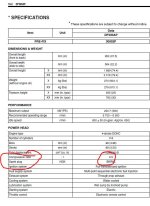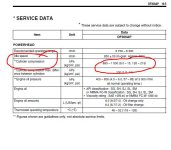Good grief, another show me and manual is not good enough.
Below is a link on how to convert compression ratio to psi.
Formula is X:Y*P= PSI
X:Y = 9.4/1 = 9.4
P = Atmospheric = 14.696
9.4:1 Ratio 9.4*14.696 = 138.1424
14:1 Ratio 14*14.696 = 205.744
https://calculator.academy/compression-ratio-to-psi-calculator/
Good grief....
That's not even remotely correct as it doesn't apply to engines....
For example, where does the formula take into account volumetric efficiency or valve timing?
Here is an example. Honda BF200 engines. The compression ratio listed in the service manual is 9.4 to 1, same as the Merc 357. The expected compression pressure as listed in the service manual is 199 to 228 PSI.
Another example, Suzuki DF300. Compression ratio 9.5 to 1. Compression pressure, 213 PSI.
So why is it a Honda outboard can generate 228 PSI of compression pressure on that same 9.4 to 1 but yet the Suzuki can only generate 213 PSI of compression when the compression ratio on the Suzuki is higher? The answer is valve timing and volumetric efficiency. The Honda and Suzuki outboard engine is more efficient and can cram more air into the cylinders than a GM-based inboard engine can.
You can certainly get more than 200 PSI of compression out of a GM small block with a hotter cam, but you can only go so hot before the engines start ingesting water through reversion.
The expected compression pressure on a new to newish GM-based marine engine is 170 to 200 PSI, and I stand by that. If you are not getting a number in that ballpark on a new engine, then either the compression gauge is faulty or the engine isn't put together right.
I've only been compression-testing marine engines for 20+ years.
Lets do 1 more for fun. A dinky little Suzuki 2.5 horsepower engine. Service manual states a compression ratio of just 9 to 1, but, that same service manual states a compression pressure of up to 199 PSI. How can that be????























